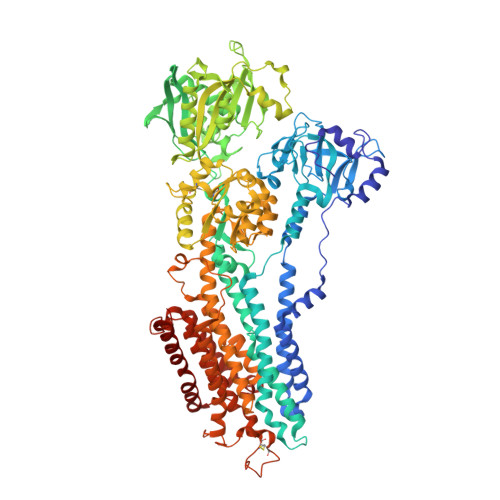Critical roles of hydrophobicity and orientation of side chains for inactivation of sarcoplasmic reticulum Ca2+-ATPase with thapsigargin and thapsigargin analogs
Winther, A.M.L., Liu, H., Sonntag, Y., Olesen, C., le Maire, M., Soehoel, H., Olsen, C.E., Christensen, S.B., Nissen, P., Moller, J.V.(2010) J Biol Chem 285: 28883-28892
- PubMed: 20551329
- DOI: https://doi.org/10.1074/jbc.M110.136242
- Primary Citation of Related Structures:
3NAL, 3NAM, 3NAN - PubMed Abstract:
Thapsigargin (Tg), a specific inhibitor of sarco/endoplasmic Ca(2+)-ATPases (SERCA), binds with high affinity to the E2 conformation of these ATPases. SERCA inhibition leads to elevated calcium levels in the cytoplasm, which in turn induces apoptosis. We present x-ray crystallographic and intrinsic fluorescence data to show how Tg and chemical analogs of the compound with modified or removed side chains bind to isolated SERCA 1a membranes. This occurs by uptake via the membrane lipid followed by insertion into a resident intramembranous binding site with few adaptative changes. Our binding data indicate that a balanced hydrophobicity and accurate positioning of the side chains, provided by the central guaianolide ring structure, defines a pharmacophore of Tg that governs both high affinity and access to the protein-binding site. Tg analogs substituted with long linkers at O-8 extend from the binding site between transmembrane segments to the putative N-terminal Ca(2+) entry pathway. The long chain analogs provide a rational basis for the localization of the linker, the presence of which is necessary for enabling prostate-specific antigen to cleave peptide-conjugated prodrugs targeting SERCA of cancer cells (Denmeade, S. R., Jakobsen, C. M., Janssen, S., Khan, S. R., Garrett, E. S., Lilja, H., Christensen, S. B., and Isaacs, J. T. (2003) J. Natl. Cancer Inst. 95, 990-1000). Our study demonstrates the usefulness of a simple in vitro system to test and direct development toward the formulation of new Tg derivatives with improved properties for SERCA targeting. Finally, we propose that the Tg binding pocket may be a regulatory site that, for example, is sensitive to cholesterol.
Organizational Affiliation:
Centre for Membrane Pumps in Cells and Disease-PUMPKIN, Danish National Research Foundation, Denmark.


















